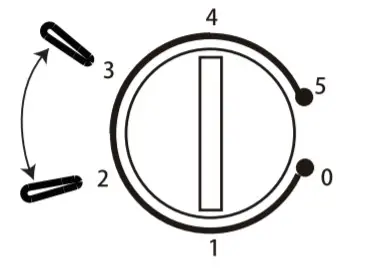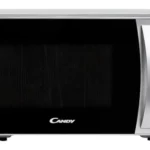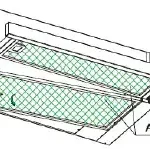
REFRIGERATOR
BEFORE USING THE APPLIANCE
Your new appliance is designed exclusively for domestic use.
To ensure the best use of your appliance, carefully read the operating instructions which contain a description of the appliance and advice on storing and preserving food. Keep this handbook for future reference.
BEFORE USING THE APPLIANCE
- Packing

The packing material is 100% recyclable and bears the recycling symbol. Comply with the local regulations for disposal. Keep the packing materials (plastic bags, polystyrene parts, etc.) out of the reach of children, as they are a potential source of danger. - Scrapping/Disposal
The appliance is manufactured using recyclable material. This appliance is marked in compliance with European Directive 2002/96/EC on Waste Electrical and Electronic Equipment (WEEE). By ensuring the correct scrapping of this appliance, you can help prevent potentially negative consequences for the environment and the health of persons.
The symbol on the appliance, or on the accompanying documents, indicates that this appliance should not be treated as domestic waste but must be taken to a suitable collection center for the recycling of electrical and electronic equipment. When scrapping the appliance, make it unusable by cutting off the power cable and removing the doors and shelves so that children cannot easily climb inside. Scrap the appliance in compliance with local regulations on waste disposal, taking it to a special collection center; do not leave the appliance unattended even for a few days, since it is a potential source of danger for children. For further information on the treatment, recovery, and recycling of this appliance, contact your
on the appliance, or on the accompanying documents, indicates that this appliance should not be treated as domestic waste but must be taken to a suitable collection center for the recycling of electrical and electronic equipment. When scrapping the appliance, make it unusable by cutting off the power cable and removing the doors and shelves so that children cannot easily climb inside. Scrap the appliance in compliance with local regulations on waste disposal, taking it to a special collection center; do not leave the appliance unattended even for a few days, since it is a potential source of danger for children. For further information on the treatment, recovery, and recycling of this appliance, contact your
1. After unpacking the appliance, make sure it is not damaged and that the door closes properly. Any damage must be reported to the dealer within 24 hours of delivery of the appliance.
2. Wait at least two hours before switching the appliance on, in order to ensure that the refrigerant circuit is fully efficient.
3. Make sure installation and the electrical connection are carried out by a qualified technician according to the manufacturer’s instructions and in compliance with the local safety regulations.
4. Clean the inside of the appliance before using it.
competent local office, the household waste collection service, or the shop where you purchased the appliance.
Information:
This appliance does not contain CFC (the refrigerant circuit contains R134a) or HFC (the refrigerant circuit contains R600a) (refer to the rating plate inside the appliance). Appliances with isobutane (R600a): Isobutane is a natural gas without environmental impact but is flammable. Therefore, make sure the refrigerant circuit pipes are not damaged.
Declaration of conformity
- This appliance is intended for storing food and is manufactured in conformity with European regulation (EC) No. 1935/2004.

- This product has been designed, manufactured, and marketed in compliance with:
– the safety objectives of Low Voltage Directive 2006/95/EC;
– the protection requirements of EMC Directive 2004/108/EC - The electrical safety of the appliance is guaranteed only if it is connected to an efficient and approved earthing system

IMPORTANT SAFETY INSTRUCTIONS
These warnings are provided In the interest of your safety. Ensure that you understand all before installing or using this appliance. Your safety is of paramount importance. If you are unsure about any of the meanings or these warnings contact the Customer Care Department.
Installation
- This appliance is heavy. Care should be taken when moving it.
- It is dangerous to alter the specifications or attempt to modify this product in any way.
- Ensure that the appliance does not stand on the electrical supply cable.
If the supply cord is damaged, it must be replaced by the manufacturer, its service agent, or similarly qualified persons in order to avoid a hazard. - Any electrical work required to install this appliance should be carried out by a qualified electrician or competent person.
- Parts that heat up should not be exposed. Whenever possible, the back of the appliance should be close to a wall but leaving the required distance for ventilation as stated in the installation instructions.
- The appliance should be left for 2 hours after installation before it is turned on, in order to allow the refrigerant to settle.
WARNING: Keep ventilation opening, in the appliance enclosure or in the built-in structure, clear of obstruction.
Child Safety
- This appliance is not intended for use by young children or infirm persons unless they have been adequately supervised by a responsible person to ensure that they can use the appliance safely.
- Young children should be supervised to ensure that they do not play with the appliance.
During Use
- This appliance is designed for domestic use only, specifically for the storage of edible foodstuffs only.
- Frozen food should not be refrozen once it has thawed out.
- Do not place carbonated or fizzy drinks in the freezer.
- Ice lollies can cause ‘frost/freezer burns’ if consumed straight from the freezer.
- Do not remove items from the freezer if your hands are damp/wet, as this could cause skin abrasions or frost/freezer burns.
Maintenance and Cleaning
- Switch off, and unplug the appliance before carrying out any cleaning or maintenance work.
- Do not use sharp instruments to scrape off frost or ice. (See defrosting instructions).
WARNING: Do not use mechanical devices or other means to accelerate the defrosting process, other than those recommended by the manufacturer.
WARNING: Do not use electrical appliances inside the food storage compartments of the appliance, unless they are of the recommended
WARNING: Do not damage the refrigerant circuit.
Servicing
This product should be serviced by an authorized engineer, and only genuine spare parts should be used.
- Under no circumstances should you attempt to repair the machine yourself. Repairs carried out by inexperienced persons may cause injury or serious malfunctioning. Contact your local Service Force Centre.
At the End of the Appliance Life
- Before discarding an old PRODUCT, switch off and disconnect it from the power supply, Cut off and render any plug useless.
- Ensure that the door cannot jam (removing it is best), regardless of whether or not it can be pushed open from inside.
AN OLD PRODUCT CAN BE A DEADLY PLAYTHING FOR CHILDREN
CAUTION: At the end of the functional life of the appliance it must be disposed of in accordance with the W.E.E.E directive (See below). Your appliance contains R600a refrigerant and inflammable gas in the insulating foam.
 Please read this instruction book carefully before use and retain it for future reference.
Please read this instruction book carefully before use and retain it for future reference.
“FOR appliances without a 4-star compartment: this refrigerating appliance is not suitable for freezing foodstuffs” “FOR a free-standing appliance: this refrigerating appliance is not intended to be used as a built-in appliance”
CORRECTLY POSITIONING
Well Ventilating
There is a need for good ventilation around the refrigerator for easy dissipation of heat, high efficiency of refrigeration, and low power consumption. For this purpose, sufficient clear space should need around the refrigerator. I am back is at least 100mm away from the wall, its sides at least have a space of 100mm separately and the height from over its top is not less than 200mm. Clear space should be left to open its doors to 160°.
Power Supply
The refrigerator is only applied with a power supply of a single-phase alternating current of (220- 240)V-/50Hz;230V-/60Hz. If fluctuation of voltage in the district user is so large that the voltage exceeds the above scope, for safety sake, be sure to apply a.c. automatic voltage regulator to the refrigerator. The refrigerator must employ a special power socket instead of a common one with other electric a appliances. Its plug must match the socket with ground wire.
Power Line Cord
The cord should be neither lengthened nor folded into the coil during operation. Moreover, it is forbidden that cord is kept close to the compressor at the back of the refrigerator, the surface temperature of which is quite high when operating. Touching with it would deactivate the insulation or cause leakage for electricity.
Protection from Moisture
Avoiding placing the refrigerator in a place where heavy moisture is present so as to minimize the possibility of rusty for its metal parts. Still more, the refrigerator is forbidden to be directly sprayed by water, otherwise, poor insulation and current leakage would occur.
Protection from Heat
The refrigerator should be far away from any heat source or direct sunshine.
Fixing Stable
The floor on which the refrigerator will be placed must be fiat and solid. It should not be laid on any soft material such as foam plastic. etc. If the refrigerator is not on the same level, adjust the screws suitably. the refrigerator should not be placed near anything which may echo.
Keep Away from Danger
It is inadvisable that the refrigerator is placed near any volatilizable or combustible such as gas. petrol. alcohol, lacquer, and banana oil. etc. The above-mentioned objects can not be stored in the refrigerator.
Moving
When fixed or moved. the refrigerator can not be set horizontally or de client to more than 45° or upside-down.
Position different food in different compartments according to be below the table
| Refrigerator compartments | Type of food |
| Door or balconies of fridge compartment | Foods with natural preservatives, such as jams, juices, drinks, condiments. Do not store perishable foods. |
| Crisper drawer (salad drawer) | Fruits, herbs, and vegetables should be placed separately in the crisper bin. | Do not store bananas, onions, potatoes, garlic in the rahiyerator. |
| Fridge shelf – middle | Dairy products, eggs |
| Fridge shelf – top | Foods that do not need cooking, such as ready-to-eat foods. deli meats, leftovers. |
- It’s suggested to set the temperature at 4°C in the fridge compartment, and, whether possible, at -18°C in the freezer compartment.
- For most food categories, the longest storage time in the fridge compartment is achieved with colder temperatures. Since some particular products (as fresh fruits and vegetables) may be damaged with colder temperatures, it is suggested to keep them in the crisper drawers, whenever present. If not present, maintain an average setting of the thermostat.
- For frozen food, refer to the storage time written on the food packaging. This storage time is achieved whenever the setting respects the reference temperatures of the compartment (one-star -6°C, two stars -12°C, three stars -18°C)
Temperature setting recommendation
| Temperature setting recommendation | ||
| Environment Temperature | Freezer compartment | Fridge compartment |
| Summer | / |  Set on 2-3 Set on 2-3 |
| Normal | / |  Set on 2-3 Set on 2-3 |
| Wing ? | / |  Set on 1-2 Set on 1-2 |
- The information above gives users a recommendation of the temperature setting.
– extended temperate (SN): ‘this refrigerating appliance is intended to be used at ambient temperatures ranging from 10 °C to 32 °C’;
– temperate (N): ‘this refrigerating appliance is intended to be used at ambient temperatures ranging from 16 °C to 32 °C’;
– subtropical (ST): ‘this refrigerating appliance is intended to be used at ambient temperatures ranging from 16 °C to 38 °C’;
– tropical (T): ‘this refrigerating appliance is intended to be used at ambient temperatures ranging from 16 °C to 43 °C’;
Cautions
- Water contained in food or getting into the air inside the refrigerator by opening doors may form a layer of frost inside. It will weaken the refuge raptor when the frost is thick, while it is more than 2mm thick, you should defrost.
- If the supply cord of this appliance is d amens& it must only be replaced by a repair shop appointed by the manufacturer because special purpose tools are required.
Care and maintenance
Replacing lamps
When replacing the lamp, proceed as follows:
– Unplug the appliance from the mains.
– Squeeze the tabs on the sides of the lamp cover and remove them.
– Replace the lamp with a new one, maximum watts recommend in the label inside the appliance next to the lamp.
– Put the lamp cover back on and wait 5 minutes before plugging the appliance back into the mains.
Troubleshooting
- WHEN THE REFRIGERATOR DOES NOT WORK
Check if there is a power failure.
Check if the power plug is plugged into the power outlet.
Check that the fuse has not blown. - WHEN THE REFRIGERATOR IS COOLING EXCESSIVELY
The temperature control dial may be set too high.
If you place foodstuffs containing a lot of moisture directly under the cool air outlets, they will freeze easily.
This does not indicate a malfunction. - WHEN THE REFRIGERATOR IS NOT COOLING SUFFICIENTLY
The food may be packed too tightly together which will block the flow of cool air.
You may have put something hot or a lot of foodstuffs into the refrigerator.
The door may not have been closed properly.
The door gaskets may be damaged.
The refrigerator may not be ventilated.
There may be insufficient clearance between the refrigerator and the surfaces Immediately on both sides and above.
The temperature control dial may not be set properly - WHEN THE DEFROSTING WATER OVERFLOWS INSIDE THE REFRIGERATOR AND ONTO THE FLOOR.
Check that the drain pipe and the drain hose are not clogged.
Check that the drain pan is housed properly. - WHEN CONDENSATION FORMS ON THE OUTSIDE OF THE REFRIGERATOR
Condensation may form on the outside when the humidity is high such as during a wet season.
This is the same result as the condensation formed when chilled water is poured into a glass.
It does not, therefore, indicate a failure, wipe dry with a dry cloth. - WHEN YOU HEAR A SOUND LIKE WATER FLOWING
A sound like water flowing is the refrigerant flowing.
It does not indicate a malfunction. - WHEN THE CABINET’S SIDE PANEL HEATS UP
The side panel of the cabinet will heat up when the door is opened or closed frequently, when starting the unit and when the unit operates in summer with high ambient outside temperature, In such case, do not touch the panel, it results from the dissipation of the heat from inside the cabinet, and it does not mean that something is wrong with the refrigerator.
Technical specifications
Tor the detailed technical specifications, please refer to the nameplate at the back of the refrigerator. ‘Specifications are subject to change without prior notice.
refrigerator
Wait at least two hours before switching the appliance on, in order to ensure that the refrigerant circuit is fully efficient.
CONTROL PANEL

The thermostat box to control the appliance is located inside the fridge compartment on the top right To check whether the appliance is functioning, make sure that the thermostat knob Is not set on “O”.
The most energy-saving configuration requires drawers, food box and shelves to be positioned in the product, please refer to the above pictures.
REVERSING THE OPENING OF THE DOORS
In order to reverse the opening of the doors, follow the indications In relation to the Insert and hinge type your product Is made up of.
| Place or tilt the fridge at a 45 angle, since it is necessary to work on the bottom of the appliance | Remove the bottom hinge by removing the screws, the plug, and washers, then remove the bottom door | Remove the caps (A) and (B), loosen the screws, and partially remove the panel. |
 |
||
| Unscrew the right hinge | Before reassembling the hinge to the left side, reverse the direction of the hinge. | Remove the plug on the left-hand side and Insert It on the right-hand-side of the door. |
 |
||
Reassemble the hinges and doors working from bottom to top, 1 D 2

GUARANTEE
Minimum guarantee is 2 years for EU Countries, 3 years for Turkey, 1 year for the UK, 1 year for Russia, 3 years for Sweden, 2 years for Serbia, 5 years for Norway, 1 year for Morocco, 6 months for Algeria, Tunisia no legal warranty required.
AVAILABILITY OF SPARE PARTS
“Thermostats, temperature sensors, printed circuit boards, and light sources are available for a minimum period of seven years after placing the last unit of the model on the market. Door handles, door hinges, trays, and baskets for a minimum period of seven years and door gaskets for a minimum period of 10 years, after placing the last unit of the model on the market”.
For further information about the product, please consult https://eprel.ec.europa.eu/ or scan the
QR on the energy label supplied with the appliance
To contact technical assistance, visit our website: https://corporate.haier-europe.com/en/
Under the section “website”, choose the brand of your product and your country. You will be redirected to the specific website where you can find the telephone number and form to contact the technical assistance.



